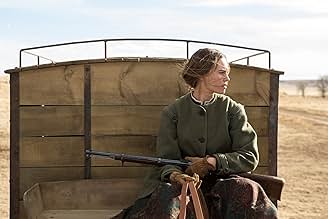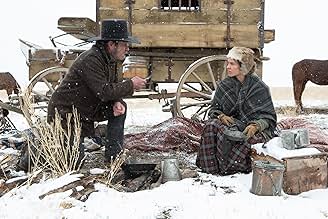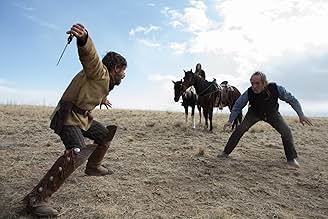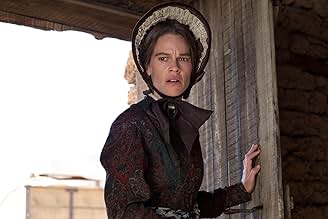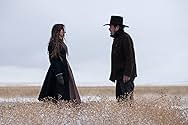Três mulheres que enlouqueceram pela vida pioneira serão transportadas através do país em um carrinho coberto pela piedosa e independente Mary Bee Cuddy, que por sua vez emprega o vagabundo ... Ler tudoTrês mulheres que enlouqueceram pela vida pioneira serão transportadas através do país em um carrinho coberto pela piedosa e independente Mary Bee Cuddy, que por sua vez emprega o vagabundo georgiano George Briggs para ajudá-la.Três mulheres que enlouqueceram pela vida pioneira serão transportadas através do país em um carrinho coberto pela piedosa e independente Mary Bee Cuddy, que por sua vez emprega o vagabundo georgiano George Briggs para ajudá-la.
- Direção
- Roteiristas
- Artistas
- Prêmios
- 5 vitórias e 14 indicações no total
Avaliações em destaque
Prarie madness sets in and three women are slated to be returned Back East. The problem is that one of the three "responsible" men is unwilling to step up, so a woman volunteers. She is strong and courageous, more than most men, but isolated and desperate for a husband because she is "bossy, and plain as an old tin can."
Her ultimate fate is incongruous, completely at odds with her character. A willful suspension of disbelief is required at this point.
Solid performances by Swank, Jones, Lithgow, and the actress who played the madwomen make it entertaining, if a bit long.
This enjoyable film is a touching and violent Western drama with elevated cinematographic values . The movie realizes an awesome actors reunion , showing the different characters and explores their apprehension , ambitions , fears and circumstances . The two protagonists result to be a pair ¨Quixotes¨ who obstinately undertake a trip whose objective looks to fulfill a pledge by whatever means . The main character George Briggs , superbly played by Tommy Lee Jones, seems to be living resolutely in the past and while the brave spinster wishes to marry him and create a family . Support cast is frankly excellent such as Barry Corbin , William Fichtner , Evan Jones , Jesse Plemons , Grace Gummer , Miranda Otto , and Tim Blake Nelson-James Spader, this duo previously appeared in ¨Lincoln¨ along with Tommy Lee and Hailee Steinfeld's second western after her Oscar-nominated , breakout role in ¨True Grit¨ . And , of course , the great Meryl Streep in her third collaboration with Tommy Lee Jones following "A Prairie Home Companion" and "Hope Springs . Intelligent and thoughtful screenplay by Kieran Fitzgerald , Wesley Oliver and the same Tommy Lee Jones , based on the novel by Glendon Swarthout that was published in 1988 ; in fact , Paul Newman owned the rights for a time, and wanted to direct the film himself , after a number of scripts, he gave up . Sensitive and evocative musical score by Marco Beltrani (Red eye , The Three Burials of Melquiades Estrada) . Special mention for glimmer and fascinating cinematography by Rodrigo Prieto he splendidly reflects the impressive outdoors from the filming locations : Lumpkin , Georgia , San Miguel County , Santa Fe , Oikay Owinger Pueblo , New Mexico . Much of the movie was shot on Tommy Lee Jones's own ranch .
The film is a nice co-production , being produced , among others , by the great producer and director , the French Luc Besson . The picture was compellingly directed by Tommy Lee Jones , being his theatrical directing debut ¨The Three Burials of Melquiades Estrada¨ that won a deserved prize in Cannes , this film bears a remarkable resemblance to ¨The Homesman¨ , dealing equally with a dangerous journey plenty of contrasts , attacks and many other things . His only other directing credits were the TV movies ¨Good old boys¨ (1995) and ¨The Sunset Limited¨ (2011) with Samuel L Jackson and all of them starred by Tommy Lee Jones . ¨Homesman¨ rating : Better than average , though overlong and slow-moving . Well worth watching , it's a must see for Tommy Lee Jones enthusiasts
The Homesman is an emotionally and powerful, idea-rich, almost humorless story -- with an immense amount of humor. It has very tight, economic tale telling with no fat on the bone; in which much is implied, historical accuracy hits its target by nuance, and the story itself is deeply respectful of an intelligent audience.
The Homesman is not "entertainment" in the haha, shoot-'em-up Western sense. It's realism committed to a moral cause -- criticism of the disenfranchised, the homeless, the people who cannot make it no matter how hard they try. It has a brilliant sense of time and place that tells the life stories of dozens of hard-enduring, long-suffering "forgotten men" -- the women no less than the men.
The key heartbreaker is Hilary Swank's character of Miss Mary Bee Cuddy. She's born into a Western frontier world where she and everyone else believes and practices that "No man, having put his hand to the plough, and looking back, is fit for the kingdom of God." Hard workers and decent people. But tragically that is not enough. Why? The Homesman leaves that question deliciously unanswered. Life is not fair. God is not just.
Beautifully The Homesman does -- kind of -- answer life's problems with the value of sheer vitality and gutsiness itself. Thus that key visual motif in the movie that comes from: George Caleb Bingham, "The Jolly Flatboatmen". We must dance the dance of life, however mad.
If you're curious to see a western that has the love of the plains of the West visually speaking ala Ford, but has the dark contours of someone like Mann - and added to that those super dirty production designs and character realizations from Spaghetti Westerns - this might be it, at least up to a point. It's so unrelentingly dark in how it looks on at the deteriorating mental states of these women, and the desperation in the journey for Jones and Swanks' characters, that the few moments of humor are rather surprising - and welcome - especially when Jones first appears to Swank on the noose and the horse. It's the kind of scene that shows this actor, well into his 60's and pushing 70, trying something new in a performance (if only for a scene or two).
It's got a cast that is practically distracting for the who's who that shows up, mostly for one scene a piece: James Spader, Tim Blake Nelson, John Lithgow, William Fichtner, Meryl Streep (!) and Hailee Steinfeld (who appears almost to have wandered from the True Grit set to this one). There's so much going for the Homesman that it's a shame the script is uneven, and there's a plot twist two thirds of the way through that is sort of explained but not at all at the same time, and it leaves the film with a gaping tragedy that can never quite be filled. Interestingly, if you watch the behind the scenes on the blu-ray one of the screenwriters mentions the book left things unexplained as well. That might be fine in the book - or perhaps more was explained in other ways - but it still doesn't work, and what Jones goes for in awe-inspiring shots he leaves behind with some muddled story beats.
Nevertheless, The Homesman is a good Western, a solid western digging into the roots of the genre and mixing the unsavory and horrifying (not like a horror movie, just some repellant images at times, but for a point), though whether one will want to return to it like other, better Westerns is another story. It's the kind of picture I can't put down for its artistry, even if things can be looked at more critically, which may explain why it didn't find its way through the End-of-Awards-time (albeit it was accepted at Cannes).
A homesman is someone tasked to bring people back to their homes. In this film, the people that needed safe transport are three mentally- disturbed women. Mary Bee McCuddy, a plain but hardy spinster, volunteered to be their homesman. Along the way, she rescues a old man Thomas Briggs from being hung by vigilantes and conscripts him to help her with her mission in exchange for saving his life. Together, they gather the three ladies and escort them from Nebraska homes across the dangerous Midwest prairie to a safe haven in Iowa.
Hilary Swank is an actress who had already won a couple of Oscars for playing strong women who had taken on masculine roles in life -- Brandon Teena in "Boys Don't Cry" and Maggie Fitzgerald in "Million Dollar Baby". As Mary Bee McCuddy, a pioneer lady who bravely accepts a task only men are expected to do, Swank again goes on the same award-baiting path. The movie worked so well when Swank was on screen. She was absolutely compelling in this offbeat role as if this was written with her in mind. The movie was not the same when her character was not there.
Tommy Lee Jones is one actor who, as of late, had seemingly been confined to playing curmudgeonly and cantankerous old men, and his Briggs here is not any different. This film is only Jones' second directorial effort since his critically-acclaimed debut in "Three Burials of Melquiades Estrada" back in 2005. As director, he was very generous to his lead female star Swank, and always gave way to let her shine. As actor, he does consistently as he is expected but this role of a grumpy old outlaw seems too familiar for him already. He wisely played Briggs with some self-deprecating humor to break the tendency of the story to become monotonously bleak.
There were some remarkable cameos from other award-winning or nominated stars in much smaller roles. John Lithgow is his usual capable self playing the Reverend Dowd who reluctantly sends McCuddy off on her task. Hailee Steinfeld plays 16-year old Tabitha Hutchinson to whom Briggs offers a surprising proposal. James Spader, in his usual over-the-top style, plays condescending hotel owner Aloysius Duffy. And last, but definitely not the least, none other than THE Meryl Streep plays perfectly kind and hospitable Altha Carter, who runs the institution in Iowa the women are headed for. These actors appear on screen for only ten minutes or so, but they leave a lasting impression.
The narrative may have been slow and desolate . However, the unusual situations, disturbing imagery, startling story developments and committed performances by the cast all keep our attention riveted. The cinematography with the muted colors worked well with the windswept landscape of its setting, as much a character in itself. The costumes and production design rang true to its mid-19th century time period. The haunting and unsettling musical score create an atmosphere of bitter emptiness. The insufferably miserable topic is clearly not for everyone. But for those who decide to give it a chance, the rewards will be satisfying. 7/10.
Você sabia?
- CuriosidadesGlendon Swarthout's novel was published in 1988. Paul Newman owned the rights, and wanted to direct the film himself. After several failed scripts, he gave up.
- Erros de gravaçãoDuring the Indian attack, every shot of the carriage has mountains in the background. The road from Nebraska to Iowa is nowhere near any mountains.
- Citações
George Briggs: Are you an angel?
Mary Bee Cuddy: You're not dead.
George Briggs: Help me. Will you help me? For God's sake.
- ConexõesFeatured in Film '72: Episode dated 19 November 2014 (2014)
- Trilhas sonorasRosalie The Prairie Flower
Music & Lyrics by George Frederick Root (as George Fredrick Root)
Performed by Hilary Swank
Principais escolhas
- How long is The Homesman?Fornecido pela Alexa
Detalhes
- Data de lançamento
- Países de origem
- Central de atendimento oficial
- Idiomas
- Também conhecido como
- Deuda de honor
- Locações de filme
- Empresas de produção
- Consulte mais créditos da empresa na IMDbPro
Bilheteria
- Orçamento
- US$ 16.000.000 (estimativa)
- Faturamento bruto nos EUA e Canadá
- US$ 2.429.989
- Fim de semana de estreia nos EUA e Canadá
- US$ 45.433
- 16 de nov. de 2014
- Faturamento bruto mundial
- US$ 3.819.421
- Tempo de duração2 horas 2 minutos
- Cor
- Mixagem de som
- Proporção
- 2.39 : 1







